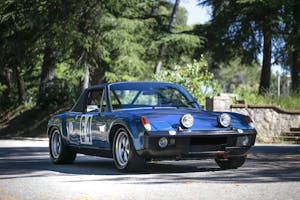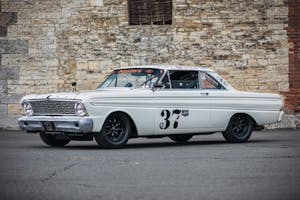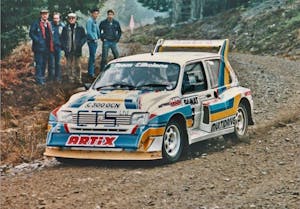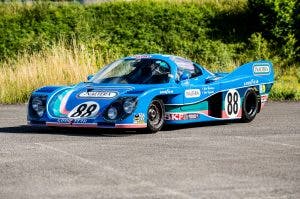6 race cars we’ll be watching at European auctions this month
As the health restrictions ease, a few racing events are starting to pop back up on the calendar. So are collector car auctions, although the situation certainly isn’t back to normal. Maybe it’s because we’ve been sorely missing wheel-to-wheel action, or maybe it’s because we’re spending too much time on the computer, but we’ve been eyeing this month’s auctions in Europe pretty closely, as there are several great race and rally cars on offer. Here are the ones we’d most like to drive in anger.
1971 Porsche 914/6 GT

Artcurial, July 21
Estimate: €280,000–€340,000 ($316,020–$383,739)
The 914/6 GT isn’t your dad’s 914. It’s essentially a 914/6 on steroids, built to race (or rally). GT specs include steel fender flares and fiberglass deck lids, rocker panels, and bumpers, plus anti-roll bars, vented 911S disc brakes, Plexiglas windows, an extra front oil cooler, a long-range fuel tank, and hotter engines all the way up to 220-hp Carrera 6 specs. Porsche built just 16 genuine GTs, one of which won its class at Le Mans. Another one, which took class honors at Daytona in 1971, sold for $995,000 at auction earlier this year.
This car has a more humble history, starting with the fact that it isn’t a factory 914/6 GT. It is, however, one of several cars converted to GT specs in period. Well-known Porsche privateer racer Max Moritz carried out the conversion for the car’s original owner, and it ran the German Rally Championship in 1971–72, winning its class at the 1972 Stuttgart-Strasbourg-Stuttgart Rally in the process. After an accident in 1975, it sat in storage until 2001 and then got a full restoration. RM Sotheby’s sold it in Paris two years ago for €241,250.
1964 Ford Falcon Sprint

Silverstone Auctions, July 31–August 1
Estimate: £80,000–£90,000 ($100,840–$113,445)
The Goodwood Revival is about as English as it gets, but some of the most entertaining cars to see sliding around the bends and dancing through the sweepers are the fast Fords from across the pond—like Mustangs, Galaxies, and Falcons. This Falcon Sprint has won at Goodwood, and at the Silverstone Classic, and is represented as “perhaps the most successful FIA Falcon on the European Historic racing scene.”
1986 MG Metro 6R4

Silverstone Auctions, July 31–August 1
Estimate: £210,000–£250,000 ($264,705–$315,125)
Austin Rover took a stab at Group B Rally glory with its Metro 6R4, but the car was a swing and a miss. Rather than going for the 2.1-liter forced induction route allowed by Group B, the 6R4 utilized a larger 3.0-liter naturally aspirated allowed by the rules. While every bit as purpose-built and extreme as the competition (just look at all those wings and scoops!), this mid-engine (very) hot hatch just didn’t have the horsepower to be a winner on the international level, although it won national events and went on to be a popular rallycross car in the 1990s. As an aside, the 6R4’s V-6 did wind up strapped with a couple of turbos when Jaguar squeezed it into the XJ220.
This 6R4 is a serious rally veteran, with an active competition career spanning well into the early 2000s. It started off in the British Rally Championship, including wins at the Wyedean Forest Rally and the Hadrian Centurion Rally. It then raced in events in Scotland and Ireland throughout the 1990s before going to Germany in the early 2000s. After a full restoration over the past four years, it looks ready to race even more in its original ARTIX team livery from the ’80s. The presale estimate, though, seems pretty ambitious. It’s over 100 grand more than the last 6R4 sold at auction.
2008 Ferrari F430 GTC Evo

Silverstone Auctions, July 31–August 1
Estimate: £350,000–£450,000 ($441,175–$567,225)
While not the most successful car Ferrari ever put on a race track, the competition versions of the F430 were a big improvement over the previous 360 GT/GTC and were competitive in high-level sports car racing all over the world. Highlights included class wins at Sebring and Le Mans as well as success in the FIA GT series and the American Le Mans Series (ALMS).
This car is one of 14 examples of the F430 GTC Evo, an improved racing version of the 430 introduced in 2008. Campaigned by the Tafel Racing team, it ran in the ALMS in period and was last raced competitively in the 2012 Pirelli World Challenge Series. It finished fourth in class (15th overall) at Sebring in 2008, ahead of its teammate but behind the Risi Competizione F430 and a pair of Porsches. At the end of the season, it had racked enough points for second in class for the championship. According to Silverstone, the original owner paid €435,000 to Ferrari for the car plus another €30,000 in options.
1983 Opel Manta 400

Artcurial, July 21
Estimate: €80,000–€120,000 ($90,291–$135,437)
Like the Metro 6R4, the Opel Manta 400 was an ambitious but unsuccessful attack on Group B from a major automaker. In the 1982 season, Opel’s Ascona was able to keep up with the Audi Quattro, so General Motors hoped that the new Group B-spec Manta 400 would be even better in 1983. Unfortunately, the naturally aspirated four-cylinder engine was down on power and the Manta’s rear-drive layout slowed it down on loose surfaces. For the most part, Opel had to watch Audi and Lancia’s epic battle from behind, but Jimmy McRae managed a podium finish at the RAC Rally and a Manta finished second at the 1984 Safari Rally.
This Manta 400 competed at the national level in France. After an accident in Guadeloupe in the Caribbean in period, it finally got restored in 2016 with a replacement Kevlar body.
1976 Inaltera GTP-Cosworth

RM Sotheby’s, July 21
Estimate: N/A
Jean Rondeau was born in Le Mans, so it’s not a huge surprise he grew up to be a racer. He spent the first half of the 1970s driving in Formula Renault and driving privateer entries at the Le Mans 24 Hour race, but then he got more ambitious and decided to build his own car. For power, Rondeau decided on the Cosworth DFV V-8 that powered Jacky Ickx and Derek Bell’s Le Mans-winning Gulf Mirage in 1975, but using a British engine meant that none of the major French carmakers would give the hometown hero financial backing. Since you definitely need money to go racing, he got backing from Inaltera, a company that made neither cars nor auto parts but wallpaper.
Underneath the slippery, finned bodywork and around the Cosworth V-8 was a spaceframe chassis with double wishbone suspension at both ends. Two Inalteras were ready for Le Mans in 1976, one of which finished eight overall and first in the GTP class. The next year Inaltera did even better, once again winning the GTP class but finishing in fourth overall behind the winning turbocharged Porsche 936, a turbocharged Gulf Mirage, and a Porsche 935.
Inaltera unexpectedly pulled their support in 1978, but Rondeau didn’t give up—he started over. The newly christened Rondeau M378 won the GTP class (ninth overall) for the team again at Le Mans in 1978, and the improved M379 finished fifth overall in 1979. Finally, the team took Le Mans overall glory in 1980, with Jean Rondeau and Jean-Pierre Jaussaud behind the wheel. That was the team’s high point, however, and it closed operations a few years later.
This car, Chassis 001 is the car that finished fourth at Le Mans in 1977, with Jean Rondeau and Jean Ragnotti driving. A later Rondeau M378 (and 10-time Le Mans veteran) crossed the block in Paris earlier this year, but was a no-sale at €680,000.

